All industries, including healthcare, require digital transformation.
Doctors and patients no longer have to regularly suffer long, tiresome appointments and complicated processes.
Why so? It is because of new digital solutions.
Yes, you read correctly.
Because of new digital tools, the delivery of healthcare has become more effective. And it was also noticeable in the COVID-19 pandemic. That was the time when doctors realized the high demand for healthcare software to combat healthcare challenges.
In the coming years, both the use of medical software and technological innovations will grow. This emphasizes the value of promoting digital healthcare projects. Even according to recent studies, it is predicted that healthcare IT solutions will reach almost $662 million by 2026. And we have also noticed several barriers falling since the pandemic began. That’s why medical professionals from around the world have agreed that digital is the future.
So, if you are running a hospital and want to take your healthcare business to the next level, then you must know the emerging trends in healthcare technology. But the question is, “Which healthcare software is best?”
To answer this, we have come up with a blog that will explain the essential healthcare software, “Lucky 17,” that always remains in demand.
So, scroll down and read this blog :
17 Types of Future Healthcare Software-Highly Popular
Here are the top 17 types of medical software that have the potential to transform the healthcare industry. Let us take a look at this lucky charm software.
1. Telemedicine
The demand for telemedicine spiked during the 2020 pandemic when the standard healthcare systems went down, and many people were unable to contact their doctors for routine in-person appointments. This need ultimately served as the spark for a revolution in worldwide digital healthcare. Even if telemedicine may no longer be as necessary as it once was, this kind of medical software has cemented itself as future health software.
Benefits of Telemedicine
- Enables distance consultations and treatment.
- Secures the storage of patient information.
- Doctors have a fantastic opportunity to boost their income.
Example: Mend
Mend is a strong patient engagement platform with unique workflows for in-person care and virtual care driven by HIPAA-compliant telemedicine to address your patient intake and communication needs.
- Increase collections, decrease the time to collect, reduce manual labor, and boost patient satisfaction.
- Make group sessions easy with secure HIPAA-complaint video conferencing and simple group scheduling.

2. Electronic Health Records Software
Electronic Health Records software is similar to a digital filing system for getting patient information. It helps in the management of personal data, medical history (including treatments and medications), and doctor recommendations.
Benefits of the EHR
- Quick diagnosis and fewer mistakes.
- Information on patients is available right away.
- Less paperwork and faster processing.
Example: Epic EMR
Epic is a comprehensive platform for electronic medical records. Epic makes it simple to manage your whole medical workflow inside of one source of truth, whether you’re a one-person clinic or the medical director at a university hospital.
Features
- Efficient patient data management with a solid electronic health records system.
- Clinical decision support tools to assist medical practitioners in making wise choices.
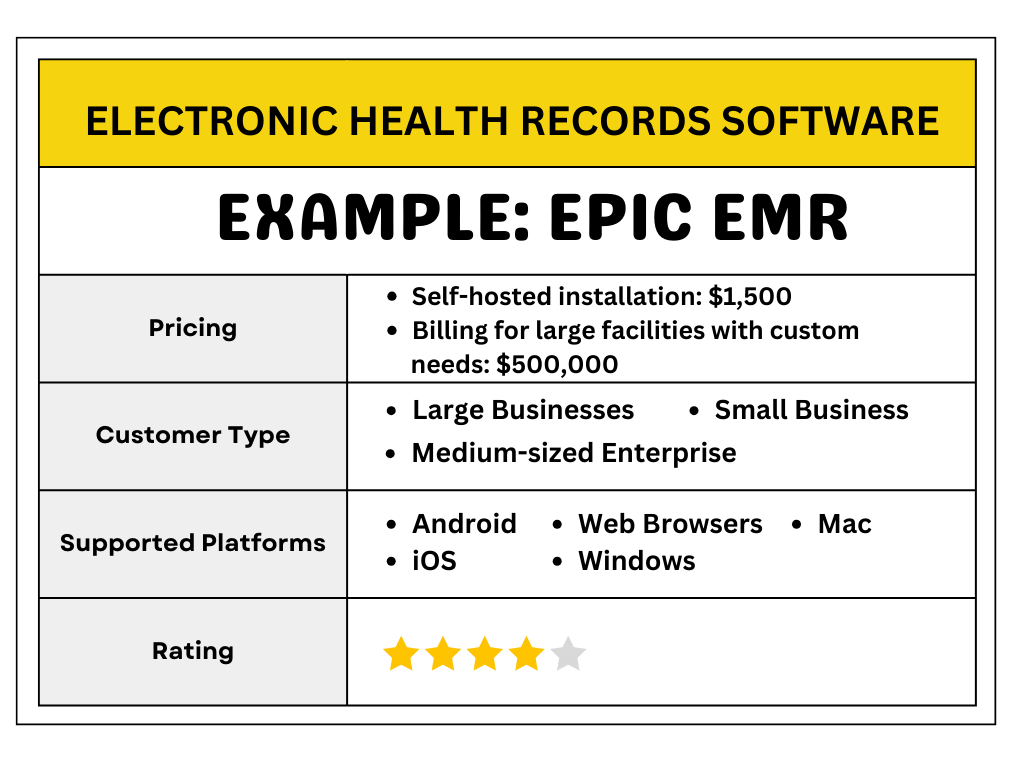
3. Hospital Management Software
The following medical software that always remains in trend is Hospital Management Software. The main task of this future health software is organizing daily operations in a hospital or clinic, from creating bills to arranging appointments. You can link this kind of software with the electronic health records system to manage patient data, payment processing, insurance information, and other tasks.
Benefits of HMS
- It makes administrative tasks more efficient.
- Less paperwork and billing errors mean lower costs.
- Makes sure that payments and invoices are accurate.
Example: SoftClinic
SoftClinic is an end-to-end hospital administration software that allows physicians, clinics, and hospitals to conduct paperless practices. It can be customized to fit the specific needs of any facility. The software includes modules such as Laboratory, Pharmacy, Human Resources, Inventory, and Accounting.
Features
- Record, monitor, and evaluate laboratory tests and results to enhance patient care and diagnoses.
- Streamlining patient appointments with effective scheduling, rescheduling, and automatic reminders.
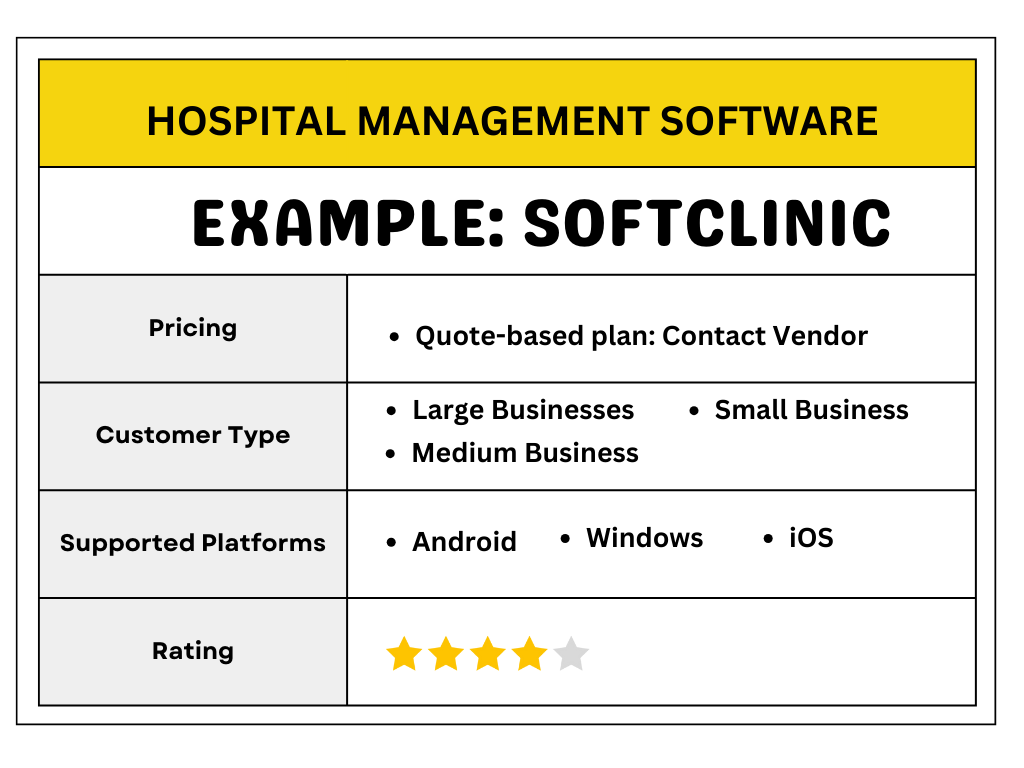
4. E-Prescribing Software
Another reason patients go to the doctor’s clinic is to get a prescription for medication; fortunately, the digital healthcare system has also made this service online. Patients and doctors both benefit from e-prescriptions. E-prescribing software makes it simpler to give direct prescriptions to the doctor.
Benefits of E-Prescribing Software
- Prescription management enables the direct transmission of prescriptions to pharmacies.
- Help to avoid circumstances where patients are left without medication.
- Help doctors decide which drug each patient responds to the best.
Example: AthenaOne
AthenaOne coordinates the provision of care, provides administrative and quality services to guarantee full reimbursement, and keeps track of all physician orders so that medical professionals may concentrate on what they do best. Provide excellent medical care.
Features
- EHR features effective e-prescribing capabilities.
- Look up the patient’s allergy and medication history.
- Check prescription coverage and formulary compliance.
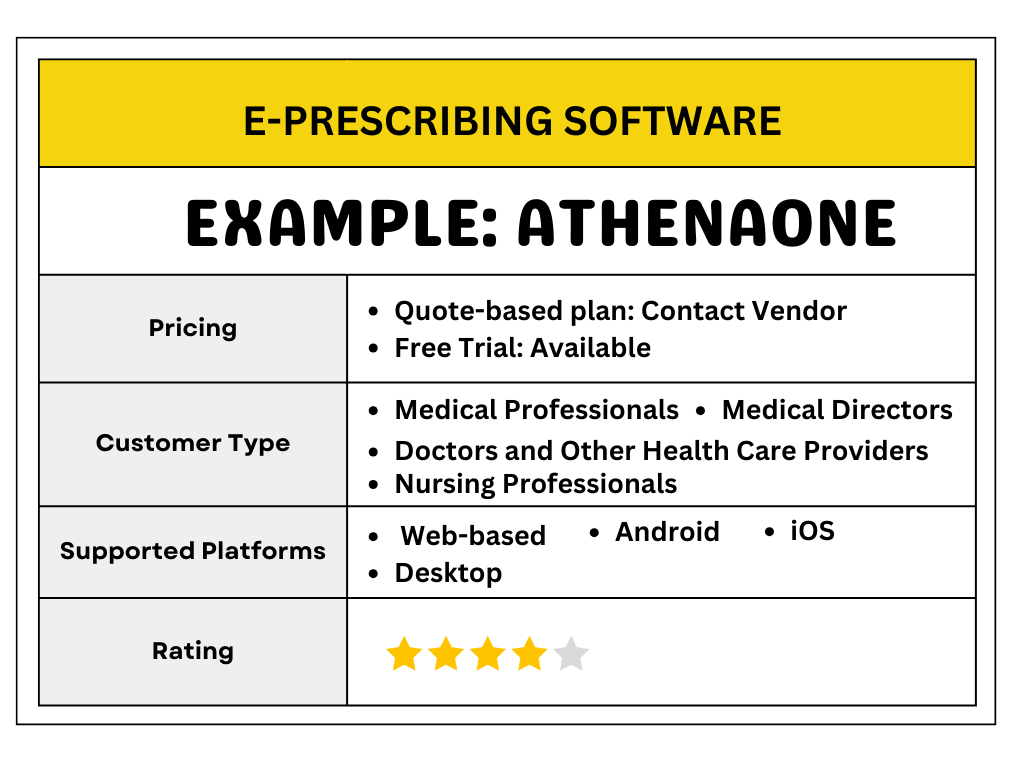
5. Software for Medical Diagnosis
The rise of AI and machine learning has had an impact on diagnostics, one of the most challenging fields of medicine. Machine learning-based diagnostic software is highly regarded in oncology since it helps with the early detection of cancer and other genetic problems as well as instances where they are challenging to identify.
Benefits of MDS
- Find defects and abnormalities by examining medical pictures like X-rays and MRIs.
- Giving advice on diagnosis and treatments based on data analysis is a form of clinical decision support.
- Create software that is tailored to the diagnostic and medical demands of particular fields.
Example: OSP Labs
OSP Labs provides various healthcare solutions, one of which is the Clinic Management System. It is a completely designed product that includes a wide range of modules for managing a hospital’s or clinic’s core functions.
Features
- OSP can create and develop specialized medical diagnostic software to meet a clinic’s or hospital’s needs.
- Such a platform makes use of numerous data sources and offers useful information on patient health.
- The diagnostic software that OSP is capable of developing guarantees thorough data protection and complies with HIPAA rules. As a result, data leaks and unwanted access are avoided.

6. Remote Patient Monitoring Software
Remote Patient Monitoring (RPM) has transformed the healthcare business by allowing patients’ data to be collected outside of traditional healthcare institutions such as clinics and hospitals. This medical software expands the breadth of available patient health information and even allows for remote diagnosis based on collected data. RPM technology, like telemedicine services, grew significantly during the pandemic since traditional health management practices were interrupted.
Benefits of RPM Software
- Enables prompt action, cutting down on problems and hospital stays.
- Collects ongoing patient health information.
- Sends notifications to healthcare providers when data veers offset bounds.
Example: TelaDoc Health
TelaDoc offers a platform for healthcare experts from all professions to engage with patients over the phone, via video, or through an app. With the help of Teladoc, patients can get medical care and medicines without ever visiting a doctor’s office.
Features
- Medical assistance is available 24 hours a day, seven days a week, including holidays.
- Patient health records must be securely stored and shared.
- When necessary, e-prescriptions are transmitted to local pharmacies.
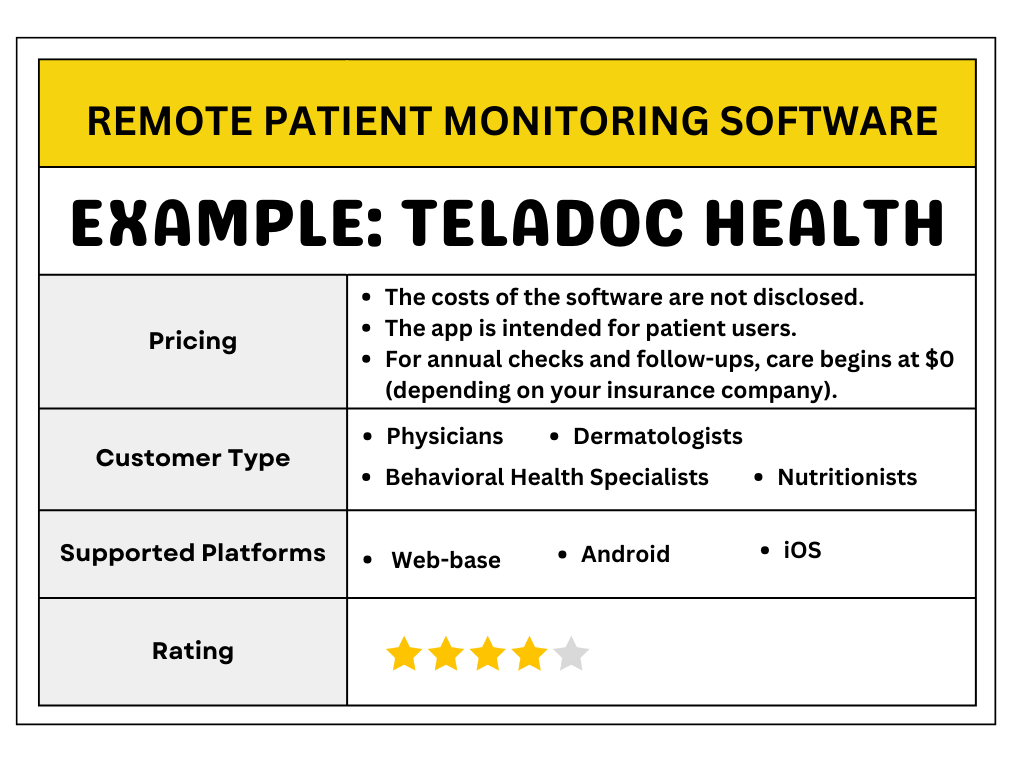
Also Read- Remote Patient Monitoring Trends these days.
7. Applications for Tracking Health
The next software that always remains in demand is health-tracking apps. It is the most diverse category of healthcare software, including diets, weight reduction, and, most recently, mental health and wellbeing apps. A growing number of apps are integrating with wearable IoT devices to collect and analyze user health data.
Benefits of Health Tracking Apps
- Encourage users to make informed decisions and become more conscious of their health behaviors.
- Provide a simple means for anyone, wherever, to monitor their health, encouraging proactive health management.
- Track your progress toward setting and achieving personal health objectives.
Example: MyFitnessPal
MyFitnessPal is a popular fitness and nutrition software that was launched by Under Armour in 2005 and has millions of users worldwide. You can use this app as a diet and fitness tracker to set weight gain or weight loss goals, calculate calories, keep a food journal, and examine the nutritional facts of the food you consume.
Features
- Keeps track of water, food, and exercise.
- Most people can get by with the free version’s features.

8. Mobile Health Apps
MHealth apps were at first considered invasive by some healthcare professionals, but they are now an essential component of modern healthcare services. By doing administrative duties like paying medical bills, making appointments, and enabling virtual consultations with nurses or doctors easier to do, these user-friendly apps empower patients.
Benefits of mHealth Apps
- These modern mHealth apps have connections with EMR/EHR software platforms.
- Make it possible to remotely monitor health indicators, chronic illnesses, and vital symptoms.
- Send out prescription reminders and keep track of compliance.
Example: Headspace
Headspace is a simple app that offers a variety of guided meditations and mindfulness exercises. It may be a good alternative for anyone new to or interested in meditation, as it provides a variety of short video options that are easy to fit into your day.
Features
- Headspace provides hundreds of videos ranging from guided meditations to breathing exercises to podcasts.
- Each day, an optional routine and plan are developed for customers to follow, which may be accessed via the app or website.

9. Medical Billing Software
Medical Billing Software is also one of the medical software that is and will be in demand. This software automates the billing procedure in the healthcare industry.
Benefits of Medical Billing Software
- Manage and monitor insurance claims effectively.
- Make patient invoices, send them, and enable online payments.
- Claim electronically to cut down on errors and delays.
Example: CareCloud
The medical billing software from CareCloud automates all aspects of the billing process, including claim cleaning and submission, coding, handling of denials, centralized billing, comprehensive analytics, payment processing, and more.
Features
- CareCloud provides you with immediate claim status visibility company-wide by automatically identifying denied claims and no-response claims.
- CareCloud’s robust appointment booking software includes multiple filters and extensive color coding.
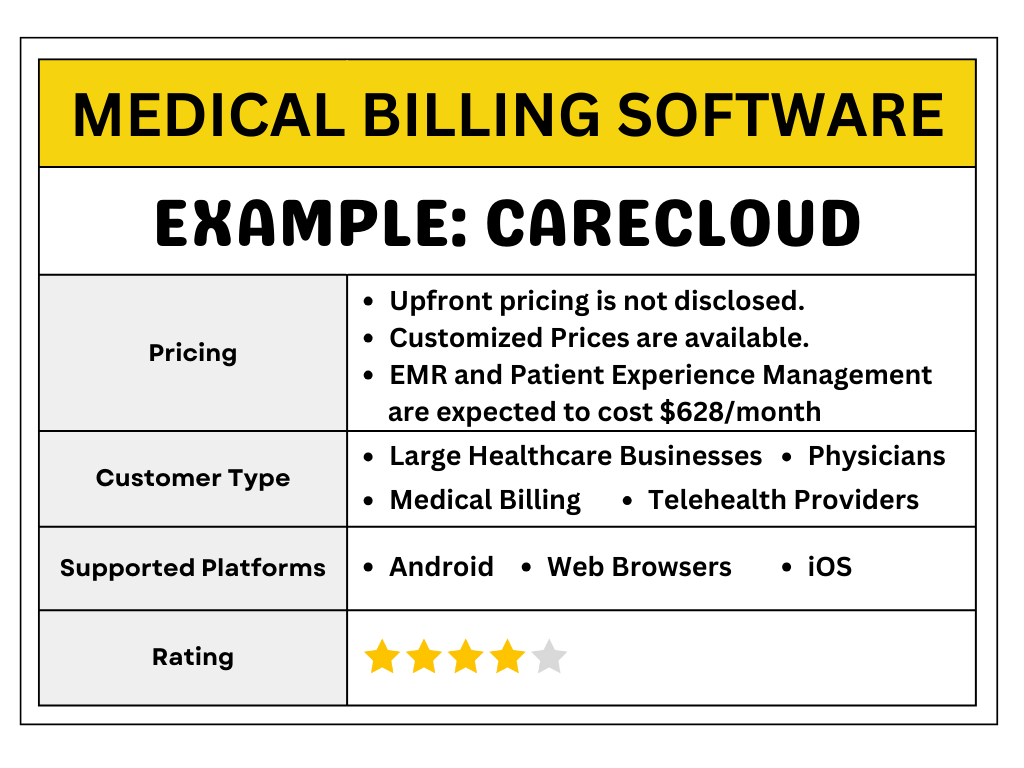
10. Appointment Scheduling Software
Appointment Scheduling Software, also known as Booking Software, supports hospitals, clinics, and medical offices in managing their appointment systems online. Typically, this medical software includes a patient panel that allows individuals to schedule appointments via an app or website.
Benefits of Appointment Scheduling Software
- Automates reservations, cutting down on manual work and avoiding double bookings.
- Gives customers the ease of making appointments online, getting reminders through email, and seeing the specifics of their meetings.
- Gather useful information on staff performance, client preferences, and appointment patterns.
Example: SimpleBook.me
SimpleBook.me is a flexible software system for scheduling medical appointments that enhances patient participation, makes planning easier, and provides insightful data analysis. It is a useful tool for healthcare professionals aiming to simplify their operations and deliver top-notch patient care due to its configurable features and dedication to security.
Features
- Simplifies the scheduling of appointments for patients and healthcare professionals.
- The program can be customized to meet the demands of healthcare practitioners. They can control appointment lengths, types, and availability to ensure that times are scheduled according to their preferences.
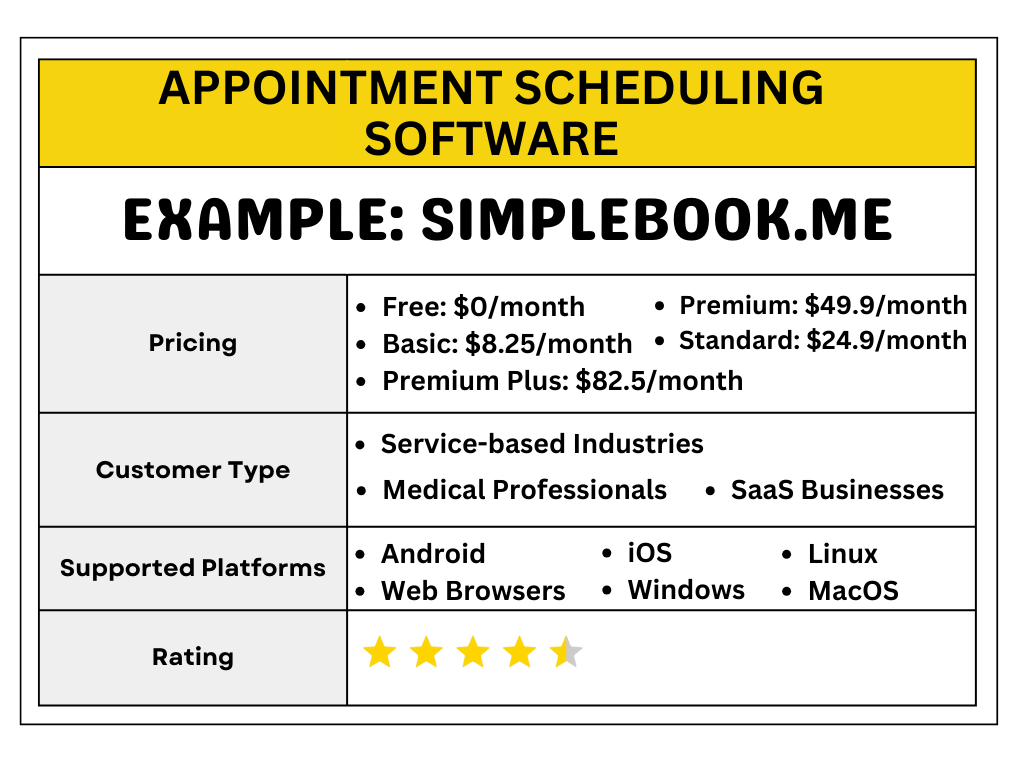
11. Medical Imaging and 3D Visualization Software
In today’s healthcare, Medical Imaging and 3D Visualization software are essential technologies that improve patient care through individualized modeling and the creation of essential medical components. These software solutions in the medical industry greatly enhance precision, efficiency, and innovation.
Benefits of Medical Imaging and 3D Visualization Software
- Enables customized treatment programs based on 3D models made specifically for each patient.
- Helps with accurate procedures and treatments, reducing risk factors.
- Improves the accuracy of medical imaging for exact identification.
Example: 3D Slicer
3D Slicer is an open-source software for planning and executing image-guided treatments as well as visualizing, processing, segmenting, registering, and analyzing medical, biomedical, and other 3D pictures and meshes.
Features
- Allows for the smooth integration and analysis of numerous data sources and supports a variety of medical imaging modalities.
- Provides strong 3D visualization tools that help with precise surgery planning and in-depth anatomical investigations.

12. Personal Health Record Software
Personal Health Record software has an advantage that sets it apart from health tracking apps, the majority of which are designed to maintain a healthy lifestyle: monitoring diseases. These software programs act as medical diaries and can be stored on the patient’s device or connected to the software used by the doctor or hospital.
Benefits of Personal Health Record Software
- Assembles all health and medical information in one secure area.
- Offers resources for establishing health objectives, controlling chronic diseases, and selecting an appropriate healthcare provider.
Example: Tulipa App
Tulipa was developed for Parkinson’s disease patients. Patients use the app to record any symptoms, sensations, medicine, or treatment and can generate a health report before their next doctor’s appointment.
Features
- With this app, you may easily keep track of your important symptoms and activities to get a sense of how you are feeling.
- This app encourages you to consider all of your drugs. It unwinds and creates space for the great things in life.
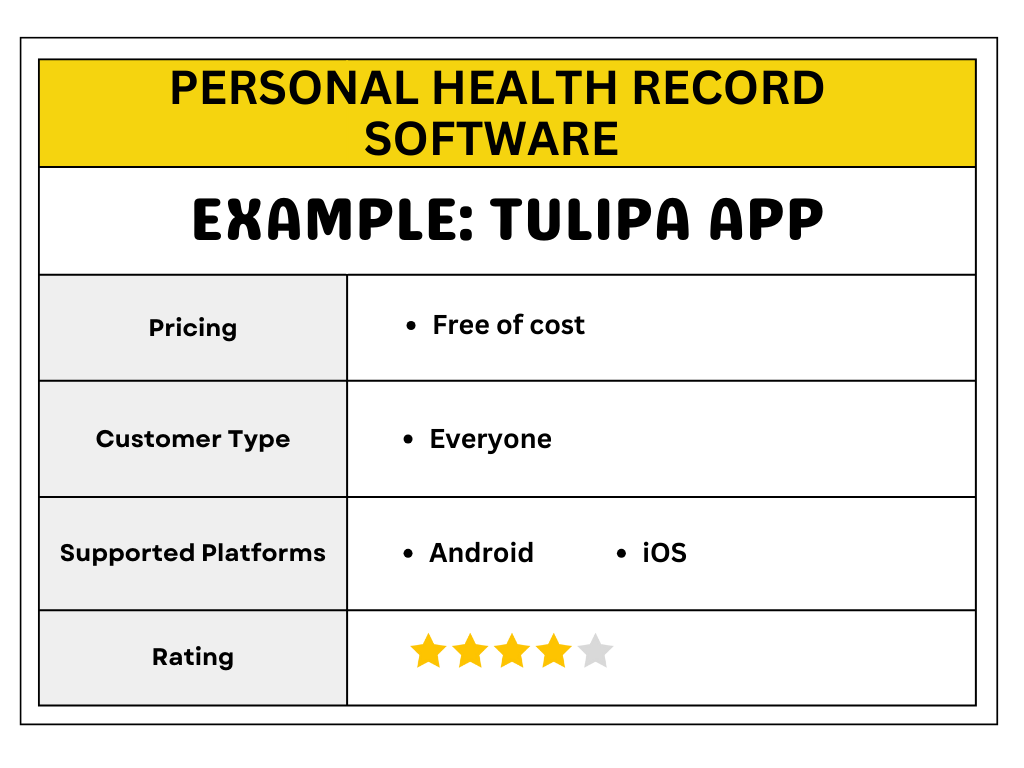
13. Medical Inventory Management System
Another best healthcare software is Medical Inventory Management software. This kind of software helps hospitals eliminate obsolete, inefficient inventory tracking systems and take control of their inventory with the touch of a few buttons.
Benefits of MEMS
- Reduces waste and ensures that vital medical supplies are available when needed by assisting with the maintenance of correct stock levels.
- Streamlines the procurement process, cuts down on expired goods, and reduces overstocking to make it easier for healthcare facilities to track and manage costs.
- Makes certain that medical staff has access to the proper drugs and equipment, thereby enhancing patient care and safety.
Example: Sortly
Sortly allows firms to manage their inventories, supplies, components, tools, and equipment from any location and on any device. Easily manage, track, update, and organize your inventory with just one simple app.
Features
- Gives customers access to a visual, image-based inventory system that enables quick organization and item identification using pictures and labels.
- Enables barcode scanning, which makes it easier to maintain and update inventory by instantly scanning things that come in and go out of stock.
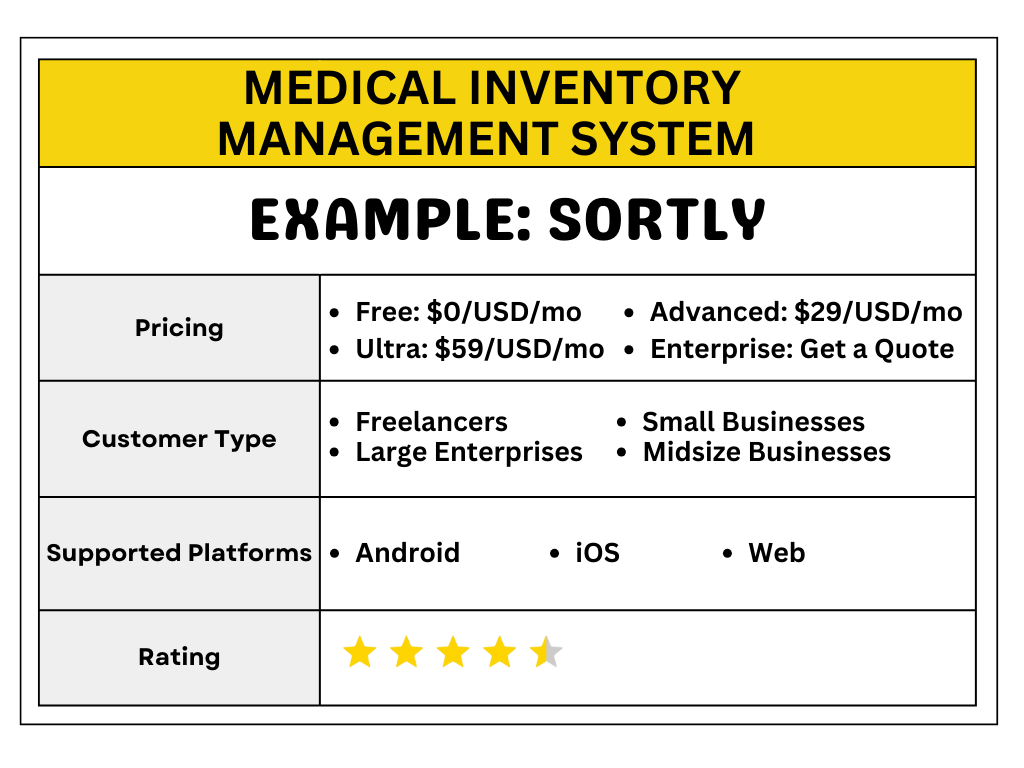
14. Computerized Maintenance Management System
Computerized Maintenance Management System ( CMMS) helps enterprises in digitizing, streamlining, and automating maintenance and operations. The main goal of this kind of medical software is to streamline maintenance procedures and enhance overall asset performance while lowering costs and downtime.
Benefits of CMMS
- Helps plan preventative maintenance, which lowers unexpected failures and increases the dependability of crucial equipment.
- Makes inventory control, asset monitoring, and work order administration more efficient, which improves maintenance operations.
- Helps in lowering operational costs and minimizing unforeseen expenses by improving maintenance procedures and extending equipment lifespan.
Example: Facilio
Facilio‘s Connected CMMS assists healthcare maintenance management with a range of operations and maintenance management (O&M) apps that can be customized for each healthcare institution and use case.
Features
- Manage assets proactively to prevent expensive repairs.
- Improve the customer experience and streamline visitor management.

15. Medical Research Software
Software for medical research is mostly used for teaching and disseminating research among medical professionals. When there are no internally referenceable clinical cases to compare patients, this kind of software is frequently used to train medical staff and support diagnosis.
Benefits of Medical Research Software
- Simplifies data gathering, administration, and integration, allowing scientists to evaluate large datasets from many sources quickly.
- Enables researchers to find patterns, trends, and insights in the data of medical research by giving them tools for in-depth data analysis and visualization.
- Enhances the quality and integrity of research projects by facilitating collaboration between research teams and ensuring that regulatory criteria are met.
Example: PubMed.gov
PubMed.gov is a freely accessible website containing a massive biomedical and life sciences literature database. The National Center for Biotechnology Information (NCBI), which is part of the National Library of Medicine (NLM) in the United States, maintains it as a free resource.
Users can search for and access a wide variety of scientific articles, research papers, clinical trials, and other medical and healthcare-related publications on PubMed.gov. It is a significant resource for researchers, healthcare professionals, and anybody looking for trustworthy information on a variety of medical and scientific topics.
While PubMed.gov is not software, it does give users access to search tools and capabilities that enable them to browse and retrieve relevant research papers and publications.
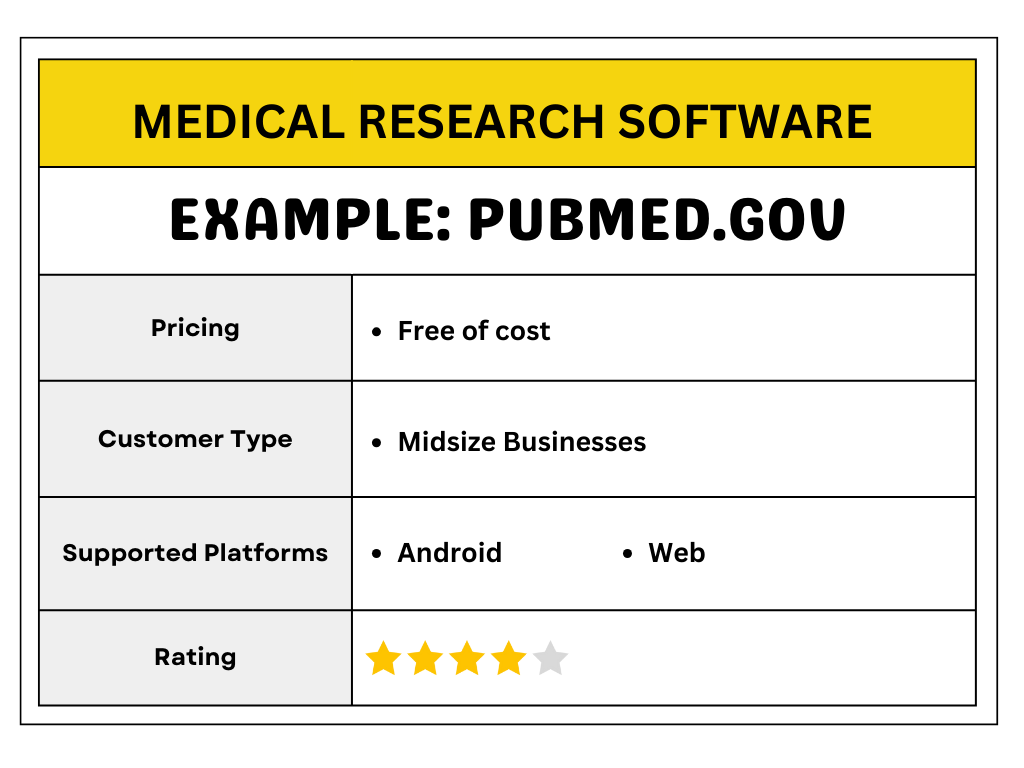
16. Patient Management Software
The next healthcare software that is used in the healthcare industry is Patient Management Software. This healthcare software outlines several efficient automated systems that monitor patient information, diagnoses, interactions, prescriptions, and encounters in medical facilities like clinics or hospitals.
Benefits of PMS
- With this software, healthcare facilities can increase revenue and patient satisfaction.
- By combining administrative systems with medical data, patient management software in the cloud accelerates processes.
- Tasks like medical billing, inventory management, appointment scheduling, lab testing, and other related activities are made simple using patient management software.
Example: eClinicalWorks
eClinicalWorks helps doctors manage all the crucial clinical components of practice for independent ambulatory facilities. This medical software offers technologies to engage patients better and enhance their experience receiving healthcare, from paperwork to scheduling.
Features
- Provide test reports, appointment notes, and other assistance to patients via the virtual assistant.
- Allow patients to arrange online appointments with their preferred doctors from the convenience of their own homes.

17. Healthcare RCM Software
Software for revenue cycle management (RCM) is designed to help healthcare providers manage their revenue cycle more effectively. This is done by automating several jobs that were previously done by human employees, like billing and collections.
Benefits of RCM Software
- Reduces revenue leakage, speeds up revenue cycles, and improves the financial performance of healthcare providers by streamlining billing and payment procedures.
- Reduces the chance of errors and non-compliance with healthcare standards, such as HIPAA, leading to fewer audits and fines by assisting in ensuring proper coding and billing.
- Enables healthcare businesses to make wise decisions and develop effective growth strategies for their finances by offering insightful information on revenue trends and patient payment habits.
Example: Cerner
Cerner offers strategic population health advising services to small practices to help them navigate the change. Performance enhancement, strategic advice services, revenue cycle management, community care management, practice management, wellness and scorecards, and registries are all available.
Features
- Offers strategic consultancy to assist practices in transitioning to value-based care.
- Cerner RCM frequently includes solutions for managing patient financial services, including patient billing, payment processing, and patient interaction.
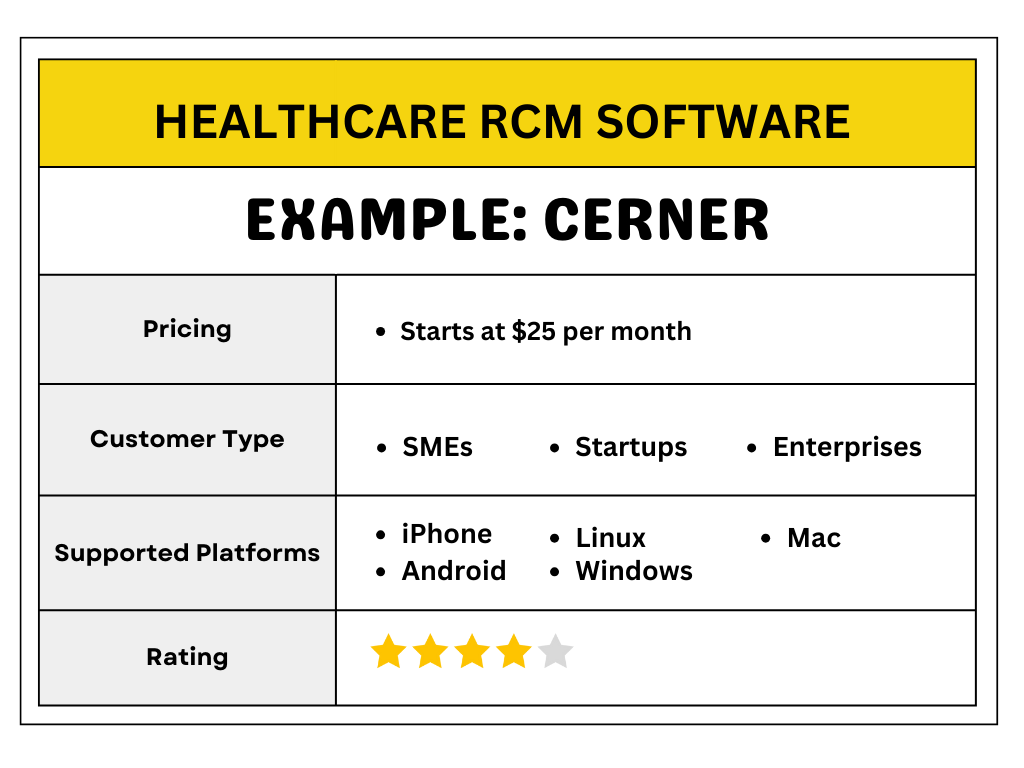
Conclusion
That’s all! Healthcare software is playing a significant role in the growing healthcare scenario, with the “Lucky 17” software signifying innovations in accessibility, efficiency, and patient-centricity. Telemedicine, electronic health records, and medical imaging software have made healthcare accessible, while artificial intelligence in diagnostics is transforming diagnostics. These advances are critical for medical professionals to give better treatment, optimize operations, and keep patients at the center of care. So, without having a second thought, take the benefits of the above-mentioned medical software right now!
Are you looking for more blogs related to software? Check out the blogs listed below:
????15 Best Software To Upscale Your Business Growth
????9 Best Warehouse Management Software You Should Try!
????12 Best Data Integration Software You Should Try
????10 Best Inventory Management Software You Must Know!!
Frequently Asked Questions
What do healthcare software systems do?
Healthcare software systems assist Doctors and nurses in the field. The treatment of patients, processing of insurance and billing, and other uses are all possible with these systems.
These systems are frequently used in hospitals or clinics where many individuals need to be watched over. People who work in isolated locations where they often cannot access the office can also use them.
Which software tools are available for healthcare professionals to employ to support their work?
Healthcare software includes a wide range of applications, including tools for producing 3D medical pictures (DICOM) and health management software. The following is a list of several frequently used pieces of unique healthcare software:
- Hospital Management Software
- Medical Imaging Software
- Telemedicine Software
- Electronic Health Records (EHR)
What medical software is the most widely used?
The most well-known and essential type of healthcare software is likely Electronic Health Records (EHR). EHR systems keep track of patient information, including their medical and family histories, results of additional tests and lab work, past prescriptions, and more.
What are the healthcare industry’s future technologies?
Advances in AI and digital technology to handle crises and enhance virtual care are trends in healthcare technology. The Internet of Medical Things (IoMT), telemedicine, mobile health, virtual conferences, and other developing themes in healthcare technology.


